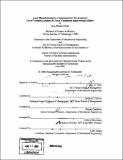Lean manufacturing in a semiconductor environment : use of variation analysis to focus continuous improvement efforts
Author(s)
Holly, Sean Michael
DownloadFull printable version (2.678Mb)
Other Contributors
Leaders for Manufacturing Program.
Advisor
Stephen C. Graves and Stanley Gershwin.
Terms of use
Metadata
Show full item recordAbstract
Intel's FAB 17 (F17), in an effort to remain competitive and reduce production cycle time, recently committed to adopt lean manufacturing as their approach to continuous improvement. To aid in this effort, the factory staff has dedicated a group people to develop tools based on lean manufacturing principles. Over the last 18 months, they have created three systematic approaches to address various forms of throughput variation, Autonomous Manufacturing (AM), Planned Maintenance (PM), and Waste Elimination (WE). Autonomous Manufacturing focuses on refurbishing manufacturing tools to new or better condition, up-skilling manufacturing technicians, and differentiating abnormal from normal operating conditions. It is meant to address throughput variation as a direct result of old, poorly maintained tools. Planned Maintenance focuses on keeping refurbished tools in new or better conditions, level loading maintenance activities, and minimizing manufacturing tool downtime due to scheduled maintenance activities. It is meant to address throughput variation as a direct result of tool availability variation. Finally, Waste Elimination focuses on optimizing the flow of information, people, and material. (cont.) It is meant to address throughput variation as a direct result of inefficient flow through the manufacturing process. This thesis provides an overview of F17's lean journey. It shows that F17 has done an excellent job of developing an infrastructure to support their lean transformation. Going forward, their major challenge will be ingraining the new principles into the existing organizational structure. A variation analysis approach uses a simple model of daily production of an operation, several key metrics that relate work in progress (WIP) flow to tool performance, and a graphical display of WIP flow and tool performance. A case study conducted identifies the most probable source of throughput variation as arrivals at one operation, tool performance at another operation, and WIP management at a third operation.
Description
Thesis (M.B.A.)--Massachusetts Institute of Technology, Sloan School of Management; and, (S.M. in Ocean Engineering)--Massachusetts Institute of Technology, Dept. of Mechanical Engineering; in conjunction with the Leaders for Manufacturing Program at MIT, 2006. Includes bibliographical references (leaf 58).
Date issued
2006Department
Leaders for Manufacturing Program at MIT; Massachusetts Institute of Technology. Department of Mechanical Engineering; Sloan School of ManagementPublisher
Massachusetts Institute of Technology
Keywords
Sloan School of Management., Mechanical Engineering., Leaders for Manufacturing Program.